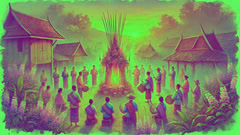Introduction
Long before steel met stone or city lights pierced the velvet dark, the northeastern plains of Thailand—Isan—unfurled in endless, sun-drenched waves of green and gold. Here, rice fields stretched like living quilts, rivers shimmered beneath the watchful gaze of the sun, and the land sang with the cycles of rain and drought, sowing and harvest. Life in Isan was shaped by the sky’s mercy: villagers whispered to the clouds and sent prayers drifting into the heavens, believing that spirits—Phi—inhabited every corner of earth and sky. Among all these unseen guardians, one spirit stood above the rest, cloaked in legend and reverence: Phi Fa, the Lady of the Sky. To the people, she was more than myth; she was hope itself, invoked at every threshold of hardship, thanked for every abundance. It was said that Phi Fa sailed on the monsoon winds, her robes woven from morning mist and twilight, her voice the echo of thunder and the hush of rain. She watched over rice paddies, shielded children from storms, and carried messages between mortals and the divine. In times of drought, when the land cracked open and hope withered on the stalk, villagers gathered for the sacred Phi Fa ritual—dancing, singing, and calling her name until their voices rose high enough to pierce the clouds. The story of Phi Fa is woven into every root and river, but none know it better than the elders of Ban Na Phu, a village perched at the edge of the Phu Phan mountains. Here, children grow up listening to tales of her miracles, while grandmothers guard secrets passed from mother to daughter. In this place, and in the memory of one young farmer named Kanya, the legend of Phi Fa would find new life—one that would test the limits of faith, reveal the bonds between earth and sky, and remind all who listen that sometimes, a prayer whispered on the wind can change the course of destiny.
The Call of the Dry Season
Kanya had never seen the land so parched. The earth cracked open beneath her bare feet as she walked the narrow dikes threading through her family’s rice paddies. The once lush fields that flanked Ban Na Phu were now brittle and gray, their emerald splendor faded under the relentless glare of the sun. Kanya’s father had tried to keep spirits high, but every morning he knelt longer before the family altar, incense curling into the stagnant air. Water jars stood empty by the well, and the river behind their house trickled on as if ashamed of its meager offering.

She remembered better times—when the river swelled in the rainy season, frogs croaked in the paddies, and her little brother would chase dragonflies through the reeds. Then, laughter filled their wooden house and her mother sang while weaving bamboo baskets in the shade. But now, fear settled on the village like a second skin. Rumors traveled from one family to the next: the rains had moved north, the gods were angry, the sky spirit had turned her face away.
One evening, as Kanya helped her mother mend a fishing net beneath the stilted house, a distant drumbeat echoed across the fields. The village elders had called a gathering at the spirit shrine, a weathered structure woven from bamboo and crowned with a garland of faded jasmine. There was talk of invoking Phi Fa, as their ancestors had in desperate years before. Kanya’s heart stirred at the name. She had heard the stories all her life: how Phi Fa’s compassion could break a drought, how her laughter could coax seeds to sprout and children to thrive. But those were tales for festival nights, spun by candlelight. Could a spirit so grand truly listen to one village among thousands?
Her grandmother’s gnarled hand found hers. “Child,” she said, voice soft as silk, “Phi Fa listens to those with true hearts. Sometimes the sky answers in ways we can’t predict.” That night, Kanya lay awake beneath a mosquito net, listening to the dry leaves scrape against the roof. She closed her eyes and whispered her own plea—not just for rain, but for hope.
At dawn, villagers gathered in their finest sarongs, clutching offerings of sticky rice, grilled fish, and woven garlands. Drummers lined the path to the shrine, their rhythms slow and urgent. The air shimmered with incense and anticipation. Kanya knelt among her friends as the elders chanted ancient verses. The headman’s wife, known for her clear voice and generous heart, began the invocation: “Phi Fa, Mother of Skies, hear our song.” Voices rose and fell, weaving through the bamboo groves, reaching for clouds that hovered just out of reach.
For hours they sang, clapped, and danced in slow circles, their bare feet stirring dust. Even the children joined, their laughter tentative at first, then brighter as the ritual grew. Kanya felt something shift—a pulse in the air, a trembling in her chest. She looked up, half-expecting to see a flash of blue silk or the sweep of a silver hand. Instead, she caught a glimpse of her neighbors’ faces: tired but shining with hope. As dusk settled, a cool breeze swept through the trees. It wasn’t rain, but it was something.
A Journey into the Mountains
That night, as the village lay in uneasy sleep, Kanya slipped from her house and made her way along a path lit by fireflies. Her grandmother’s words echoed in her ears: true hearts could call to Phi Fa. She believed it now, in a way she never had before. At the edge of the rice fields, she stopped to offer a simple prayer—a handful of rice, a whispered promise to care for the land if only the sky would show mercy. The breeze stirred, carrying the scent of jasmine and distant rain.

Kanya’s journey took her toward the Phu Phan mountains, where legend said the veil between worlds grew thin. She walked all night, her woven basket slung across her back, feet moving by memory and moonlight. As dawn colored the sky, she climbed through tangled forests alive with cicada song and the flash of birds’ wings. She crossed streams that shimmered with promise, stepped over roots ancient as the village itself. Each time doubt crept in, she remembered stories her mother told: how heroes found Phi Fa not by force, but by kindness and courage.
By midday, she reached a clearing where a waterfall spilled silver ribbons into a mossy pool. Here, the air felt different—heavy with possibility. Kanya knelt by the water, washing her face and offering the river a silent thanks. She unpacked her basket: a tiny clay doll shaped like a woman in swirling robes, a string of blue beads her mother once wore, and a sprig of fresh lemongrass. She built a small altar of stones and placed her gifts there, arranging them with trembling hands. “Phi Fa,” she whispered, “please hear me. My people are afraid. I have nothing to give but my heart.”
The forest hushed. A single cloud drifted overhead, shading the pool. Then, from the waterfall’s mist, a shape began to form: tall and graceful, wrapped in robes of sky-blue and dawn gold. Kanya felt awe—equal parts fear and wonder—as the spirit of Phi Fa revealed herself. Her face was both ancient and young, her eyes deep as rain-fed lakes. She spoke with a voice that shimmered like wind in bamboo leaves: “You have come far, little one. Why do you seek me?”
Kanya told her everything—about the drought, her family’s struggle, the hope flickering in her village. Phi Fa listened with grave attention, her hands tracing gentle ripples through the air. “The land suffers when harmony is broken,” she said. “To restore balance, you must carry my message home. Tell your people: care for the rivers, honor the old ways, share what you have even in hunger. If you do this, the sky will remember you.” Kanya promised she would, tears springing to her eyes. The spirit smiled and pressed a dewdrop into Kanya’s palm—cool, shimmering, and impossibly bright. “This is my blessing. Guard it well.”
As the morning sun broke through the clouds, Phi Fa faded into mist. Kanya turned for home, her heart lighter than it had been in months.
The Rain’s Return
The journey back felt dreamlike. Kanya clutched the dewdrop tightly, afraid it might vanish if she looked away. Along the way, she noticed subtle changes: birds singing louder, leaves glistening with fresh dew, even the air tasted sweeter. Villagers greeted her with tired smiles as she returned—her mother rushing to embrace her, her father’s eyes brimming with unspoken questions. Kanya shared her story with her family first, then with the elders who gathered in hushed circles by the shrine. Some doubted; others saw hope flickering in her eyes and remembered their own childhood encounters with the unseen.

The next morning, Kanya and her grandmother led a procession to the riverbank. The entire village followed—children carrying flowers, elders holding handmade lanterns, everyone dressed in their brightest clothes. Kanya stood at the water’s edge and opened her palm. The dewdrop glowed fiercely for an instant, then rose into the sky like a tiny sunbeam. As she watched, clouds began to gather—slowly at first, then tumbling over one another in a rush. Thunder rumbled in the distance. A cool wind swept through the crowd, lifting hair and hopes alike.
The first raindrops fell in silence—soft and tentative, like the opening notes of a lullaby. Then the downpour came, warm and steady, drumming on rooftops and rice stalks, filling empty jars and hearts. Children danced barefoot in the mud, elders laughed and wept in equal measure. Kanya’s family rushed to bring out bowls and pots, catching every drop they could. In the fields, frogs sang their joy as green shoots broke through the crusted earth.
As the rains settled into a gentle rhythm, life returned to Ban Na Phu. The river swelled and sparkled once more. Harvest season arrived with abundance not seen in years: golden rice bending low under its own weight, vegetables blossoming in riotous colors, fish leaping silver arcs in full ponds. Villagers kept their promise to Phi Fa. They tended the land with care, repaired old irrigation channels, planted trees along the riverbanks, and shared their harvest with neighboring villages struck by drought. Each year, they renewed their thanks with festivals—dancing under lanterns, feasting on sticky rice and mangoes, and singing songs older than memory.
Kanya grew into a wise young woman, sought for advice and comfort. Whenever someone doubted the spirit’s presence, she pointed to the lush fields and bright sky, reminding them that harmony required both effort and gratitude. The story of her journey became legend—a tale mothers whispered to restless children on humid nights. And each time thunder rumbled on the horizon, villagers would glance upward and smile, knowing that Phi Fa watched over them still.
Conclusion
The legend of Phi Fa endures wherever the rhythm of rain and soil shapes daily life. Generations later, Ban Na Phu still celebrates her gift, not just in ritual but in everyday acts of kindness—planting trees, sharing food, mending rivers. Children run through green paddies, their laughter rising like birdsong toward the open sky. Elders pass on stories beneath ancient tamarind trees, reminding all who listen that the spirit of the land is never far away. Kanya’s tale reminds us that faith alone isn’t enough; harmony with nature demands action, compassion, and respect for old wisdom. The bond between earth and sky—between human hearts and the unseen world—is fragile yet resilient, woven anew each season by those who remember to ask, to thank, and to care. In honoring Phi Fa, villagers honor themselves and all who came before them. And when rain falls at last, it isn’t just water from the clouds—it’s a promise kept, a blessing earned, and a legend living on in every bright green blade.













